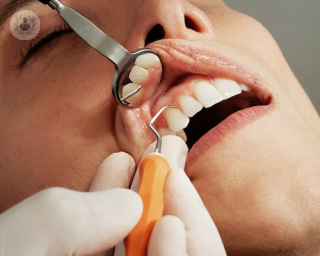What is periodontitis?
Periodontitis can occur in a more advanced stage of periodontal disease, otherwise known as gum disease. Periodontitis occurs when the inflammation of the gums extends to the ligaments and bones that support the teeth, leading to the teeth loosening or falling out.

What are the symptoms?
The symptoms of periodontitis are very similar to those of gingivitis:
- the gums are red or purple, instead of their natural pink colour
- the gums bleed during brushing, or afterwards
- bad breath
- loose teeth
- pain when touching the gums
What causes periodontitis?
Gingivitis can progress to periodontitis if it is not treated properly. Gingivitis is treatable and reversible, whereas periodontitis is a more serious condition, as it can lead to tooth and bone loss, which are irreversible. There is also a genetic component to periodontitis, and some people are more susceptible to the disease than others.
If you smoke, or have diabetes, then the risk of periodontitis is also higher.
Can periodontitis be prevented?
Proper dental hygiene is the best way to prevent periodontitis. In fact, it is important to maintain good dental hygiene habits to prevent gingivitis in the first place, which is the periodontal disease that can trigger periodontitis.
The prevention and proper treatment of gingivitis can prevent periodontitis.
What is the treatment of periodontitis?
The first step is to reduce inflammation and remove plaque affixed to the teeth and gums. To do this, complete professional dental hygiene must be performed, which should be repeated once every three months or following the recommendations of your dentist to prevent plaque from accumulating again. The patient should also maintain thorough brushing and flossing habits.
The treatment of periodontitis may also include surgery to remove infection from the gums and to rebuild the tooth supports. The operation will consist of opening the gums to clean them deeply, provide support to the teeth that are loose and even extract a severely affected tooth to prevent the problem from spreading to the other teeth.
10-28-2015 12-21-2023Periodontitis
Dr Crystal Marruganti - Dentistry
Created on: 10-28-2015
Updated on: 12-21-2023
Edited by: Carlota Pano
What is periodontitis?
Periodontitis can occur in a more advanced stage of periodontal disease, otherwise known as gum disease. Periodontitis occurs when the inflammation of the gums extends to the ligaments and bones that support the teeth, leading to the teeth loosening or falling out.

What are the symptoms?
The symptoms of periodontitis are very similar to those of gingivitis:
- the gums are red or purple, instead of their natural pink colour
- the gums bleed during brushing, or afterwards
- bad breath
- loose teeth
- pain when touching the gums
What causes periodontitis?
Gingivitis can progress to periodontitis if it is not treated properly. Gingivitis is treatable and reversible, whereas periodontitis is a more serious condition, as it can lead to tooth and bone loss, which are irreversible. There is also a genetic component to periodontitis, and some people are more susceptible to the disease than others.
If you smoke, or have diabetes, then the risk of periodontitis is also higher.
Can periodontitis be prevented?
Proper dental hygiene is the best way to prevent periodontitis. In fact, it is important to maintain good dental hygiene habits to prevent gingivitis in the first place, which is the periodontal disease that can trigger periodontitis.
The prevention and proper treatment of gingivitis can prevent periodontitis.
What is the treatment of periodontitis?
The first step is to reduce inflammation and remove plaque affixed to the teeth and gums. To do this, complete professional dental hygiene must be performed, which should be repeated once every three months or following the recommendations of your dentist to prevent plaque from accumulating again. The patient should also maintain thorough brushing and flossing habits.
The treatment of periodontitis may also include surgery to remove infection from the gums and to rebuild the tooth supports. The operation will consist of opening the gums to clean them deeply, provide support to the teeth that are loose and even extract a severely affected tooth to prevent the problem from spreading to the other teeth.


How to treat severe periodontitis
By Professor Christian Mehl
2025-01-26
Did you know that approximately 18 million brits have some form of periodontitis? Roughly 12% of them have a case where it is severe. It can cause swollen gums but not only this, it can also damage tissue and lead to a loss of teeth. A leading dentist based in London, Professor Christian Mehl, spoke with us about periodontal treatment and what it entails, in this article he also covers guided tissue regeneration. See more


Liver inflammation and gum disease: Is there a link?
By Dr Sulaman Anwar
2025-01-26
In this article, we hear expert insight on the latest studies relating to liver health and its association with gum disease from Dr Sulaman Anwar, a specialist periodontist and implant surgeon. See more


How smoking affects your oral health
By Dr Neesha Patel
2025-01-26
All tobacco use, whether it be smoking or chewing tobacco, has a negative impact on a person’s health. Smoking and tobacco is not only linked to illnesses such as heart disease, lung disease and cancer, but can also have a huge impact on your oral health, putting you at a higher risk of periodontal (gum) disease and oral cancer. Take a closer look at the relationship between tobacco use and both periodontal disease and oral cancer with leading consultant periodontist, Dr Neesha Patel. See more


What results can I expect after having Invisalign?
By Dr Alga Zelda
2025-01-22
Invisalign uses a series of clear, removable aligners which straighten teeth gradually. Many patients choose it for its discreet appearance and convenience compared to traditional braces. Understanding the results you can expect from Invisalign is essential for making an informed decision, and highly-respected cosmetic dentist Dr Alga Zelda is here to tell us all about it. See more
Experts in Periodontitis
-
Dr Crystal Marruganti
DentistryExpert in:
- Periodontitis
- Dental crown
- Receding gums
- Gummy smile
- Periodontal cleaning
- Periodontal Surgery
-
Dr Tania Rafael Garcia
PeriodontologyExpert in:
- Periodontics
- Dental implants
- Tooth abscess
- Bone and periodontal regeneration
- Periodontitis
- Periodontal cleaning
-
Dr Georgina Rafel Vernet
DentistryExpert in:
- Periodontal cleaning
- Gum graft
- Periodontitis
- Periodontics
- Periodontal Surgery
- Gingivitis
-
Dr Francesca Bianchi
DentistryExpert in:
- Gingivitis
- Peri-implantitis
- Periodontitis
- Periodontal cleaning
- Dental implants maintenance
- Teeth whitening
- See all

Harley Street Dental Studio
Harley Street Dental Studio
52 Harley Street, Marylebone. W1G 9PY
No existe teléfono en el centro.
By using the telephone number provided by TOP DOCTORS, you automatically agree to let us use your phone number for statistical and commercial purposes. For further information, read our Privacy Policy
Top Doctors

Italian Doctors
Italian Doctors
24E Little Russell St, London, WC1A 2HS
No existe teléfono en el centro.
By using the telephone number provided by TOP DOCTORS, you automatically agree to let us use your phone number for statistical and commercial purposes. For further information, read our Privacy Policy
Top Doctors

Forest & Ray - Dentists, Orthodontists, Implant Surgeons
Forest & Ray - Dentists, Orthodontists, Implant Surgeons
8F Gilbert Pl, London, WC1A 2JD
No existe teléfono en el centro.
By using the telephone number provided by TOP DOCTORS, you automatically agree to let us use your phone number for statistical and commercial purposes. For further information, read our Privacy Policy
Top Doctors
-
Harley Street Dental Studio
52 Harley Street, Marylebone. W1G 9PY, W1G Marylebone LondonExpert in:
- Porcelain veneers
- Crowns
- Fillings
- Endodontics
- Cosmetic dentistry
- Dental implants
-
Italian Doctors
24E Little Russell St, London, WC1A 2HS, Central LondonExpert in:
- Cardiology
- Gastroenterology
- Obstetrics and Gynaecology
- Dentistry
- Paediatrics
- Psychiatry
-
Forest & Ray - Dentists, Orthodontists, Implant Surgeons
8F Gilbert Pl, London, WC1A 2JD, Central LondonExpert in:
- Braces
- Porcelain veneers
- Crowns
- Cosmetic dentistry
- Dental implants
- Orthodontics
- See all
- Most viewed diseases, medical tests, and treatments
- Trigeminal neuralgia
- Snoring
- Chronic headache
- Facial feminisation surgery
- Head and neck cancer
- Neck lump
- Botulinum toxin (Botox™)
- Platelet-rich plasma
- Sialendoscopy
- Cleft palate






